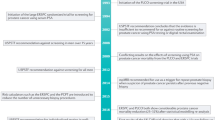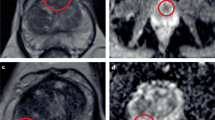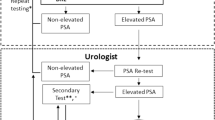Abstract
To examine the practice of repeating an abnormal prostate-specific antigen (PSA) level before proceeding to prostate biopsy, we assessed the pattern of PSA change following an initially raised (⩾4.0 ng ml−1) PSA, and the relationship of this to prostate cancer diagnosis. In 7052 men, 71.2% with initially raised PSA had a reduction in PSA, with values <4.0 ng ml−1 in 37.8%. A total of 43.0% of men with prostate cancer showed a PSA decrease below their baseline level. Short-term decreases in PSA may occur in men with prostate cancer, including high-grade cancer, and so should not influence the decision to proceed to prostate biopsy.
This is a preview of subscription content, access via your institution
Access options
Subscribe to this journal
Receive 4 print issues and online access
$259.00 per year
only $64.75 per issue
Buy this article
- Purchase on Springer Link
- Instant access to full article PDF
Prices may be subject to local taxes which are calculated during checkout

Similar content being viewed by others
References
Carter HB, Pearson JD, Metter EJ, Brant LJ, Chan DW, Andres R et al. Longitudinal evaluation of prostate-specific antigen levels in men with and without prostate disease. JAMA 1992; 267: 2215–2220.
Smith DS, Catalona WJ . Rate of change in serum prostate specific antigen levels as a method for prostate cancer detection. J Urol 1994; 152: 1163–1167.
Mettlin C, Murphy GP, Lee F, Littrup PJ, Chesley A, Babaian R et al. Characteristics of prostate cancer detected in the American Cancer Society-National Prostate Cancer Detection Project. J Urol 1994; 152 (5 Part 2): 1737–1740.
Eastham JA, Riedel E, Scardino PT, Shike M, Fleisher M, Schatzkin A et al. Variation of serum prostate-specific antigen levels: an evaluation of year-to-year fluctuations. JAMA 2003; 289: 2695–2700.
Soletormos G, Semjonow A, Sibley PE, Lamerz R, Petersen PH, Albrecht W et al. Biological variation of total prostate-specific antigen: a survey of published estimates and consequences for clinical practice. Clin Chem 2005; 51: 1342–1351.
Singh R, Cahill D, Popert R, O′Brien TS . Repeating the measurement of prostate-specific antigen in symptomatic men can avoid unnecessary prostatic biopsy. BJU Int 2003; 92: 932–935.
Gavin A, McCarron P, Middleton RJ, Savage G, Catney D, O′Reilly D et al. Evidence of prostate cancer screening in a UK region. BJU Int 2004; 93: 730–734.
Connolly D, Black A, Gavin A, Keane PF, Murray LJ . Baseline prostate-specific antigen level and risk of prostate cancer and prostate-specific mortality: diagnosis is dependent on the intensity of investigation. Cancer Epidemiol Biomarkers Prev 2008; 17: 271–278.
Ito K, Yamamoto T, Ohi M, Takechi H, Kurokawa K, Suzuki K et al. Natural history of PSA increase with and without prostate cancer. Urology 2003; 62: 64–69.
Carter HB, Pearson JD, Waclawiw Z, Metter EJ, Chan DW, Guess HA et al. Prostate-specific antigen variability in men without prostate cancer: effect of sampling interval on prostate-specific antigen velocity. Urology 1995; 45: 591–596.
Prestigiacomo AF, Stamey TA . Physiological variation of serum prostate specific antigen in the 40 to 10.0 ng/ml. range in male volunteers. J Urol 1996, 1977–1980.
Ornstein DK, Smith DS, Rao GS, Basler JW, Ratliff TL, Catalona WJ . Biological variation of total, free and percent free serum prostate specific antigen levels in screening volunteers. J Urol 1997; 157: 2179–2182.
Boddy JL, Pike DJ, Al-Hayek S, Shaida N, Malone PR . An elevated PSA, which normalizes, does not exclude the presence of prostate cancer. Prostate Cancer Prostatic Dis 2005; 8: 349–352.
Hamdy FC, Dedman D, Lane A, Oliver S, Powell P, Leung H et al. The value of repeat serum PSA measurements in the detection of prostate cancer—experience from the feasibility phase of the UK ProTect study. J Urol 2006; 175 (Suppl 4): 153.
Thompson IM, Pauler DK, Goodman PJ, Tangen CM, Lucia MS, Parnes HL et al. Prevalence of prostate cancer among men with a prostate-specific antigen level < or =40 ng per milliliter. N Engl J Med 2004; 350: 2239–2246.
Acknowledgements
This research was funded by the Northern Ireland Research and Development Office and by the Men Against Cancer charity. The Northern Ireland Cancer Registry was funded by the Department of Health, Social Services & Public Safety Northern Ireland (DHSSPSNI).
Author information
Authors and Affiliations
Corresponding author
Additional information
Conflict of interest
There is no conflict of interest for any author.
Rights and permissions
About this article
Cite this article
Connolly, D., Black, A., Murray, L. et al. Repeating an abnormal prostate-specific antigen (PSA) level: how relevant is a decrease in PSA?. Prostate Cancer Prostatic Dis 12, 47–51 (2009). https://doi.org/10.1038/pcan.2008.37
Received:
Revised:
Accepted:
Published:
Issue Date:
DOI: https://doi.org/10.1038/pcan.2008.37
Keywords
This article is cited by
-
Risk-stratified multi-round PSA screening for prostate cancer integrating the screening reference level and subgroup-specific progression indicators
European Journal of Medical Research (2023)
-
Daily, monthly and seasonal variation in PSA levels and the association with weather parameters
Prostate Cancer and Prostatic Diseases (2011)



